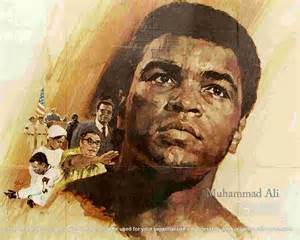 Muhammad Ali, known as the greatest boxer of all times and viewed by most as the “Champ,” retired as the first three-time Heavyweight Champion of the World. He was born Cassius Marcellus Clay Jr., the elder of two boys in Louisville, Kentucky, on January 17, 1942. He was named after his father, Cassius Marcellus Clay Sr., who was named after the 19th-century abolitionist and politician, the owner of Clay’s ancestors. Ali changed his name after joining the Nation of Islam in 1964.
Muhammad Ali, known as the greatest boxer of all times and viewed by most as the “Champ,” retired as the first three-time Heavyweight Champion of the World. He was born Cassius Marcellus Clay Jr., the elder of two boys in Louisville, Kentucky, on January 17, 1942. He was named after his father, Cassius Marcellus Clay Sr., who was named after the 19th-century abolitionist and politician, the owner of Clay’s ancestors. Ali changed his name after joining the Nation of Islam in 1964.
Clay was directed toward boxing by a white Louisville police officer whom he encountered as a 12-year-old fuming over the theft of his bicycle. After an extremely successful amateur boxing career, he won a gold medal in the light heavyweight division at the 1960 Summer Olympics in Rome. Ali said in his 1975 autobiography that he threw his Olympic gold medal into the Ohio River after being refused service at a “whites-only” restaurant.
Not only was the Champ a fighter in the ring, but he also had the courage to fight the U.S. Government in 1967 when he refused to be inducted into the U.S. military based on his religious beliefs and opposition to the Vietnam War. He was arrested and found guilty on draft evasion charges, stripped of his boxing title, and his boxing license was suspended. He was not imprisoned but did not fight again for nearly four years while his appeal worked its way up to the U.S. Supreme Court, where it was successful.
Standing tall at 6 feet, 3 inches, Clay had a highly unorthodox style for a heavyweight boxer. Rather than the normal style of carrying the hands high to defend the face, he instead relied on foot speed and quickness to avoid punches and carried his hands low. He coined a new technique called the rope-a-dope where he rested on the ring ropes and let the dope, his opponent, punch himself out. He was also known for his pre-match hype, where he would “trash talk” opponents on television and in person before the match and often with rhymes.
These personality quips and idioms, along with an unorthodox fighting technique, made him a cultural icon. Ali built a reputation by correctly predicting, with stunning accuracy, the round in which he would “finish” an opponent. While still Cassius Clay, he adopted the latter practice from “Gorgeous” George Wagner, a popular professional wrestling champion who drew thousands of fans. Often referred to as “the man you loved to hate,” George could incite the crowd with a few heated remarks, which Ali used to his advantage.
As Clay, he met his famous longtime trainer Angelo Dundee during a light heavyweight fight in Louisville shortly after becoming the top contender to fight Heavyweight Champion Sonny Liston. Despite his impressive record, he was not widely expected to defeat Liston, who was considered a more sinister champion than Iron Mike Tyson. In fact, nobody gave him a snowball’s chance in hell of winning the fight against such a dominant champion.
The fight was scheduled for February 25, 1964, in Miami, Florida, but it almost never happened because the promoter heard that Clay had been seen around Miami and in other cities with the controversial Muslim Leader, Malcolm X. The promoters perceived this association as a potential gate killer to the fight where Liston was overwhelmingly favored to win. However, it was Clay’s colorful persona and nonstop braggadocio that gave the fight its sole appeal.
The ever-boastful Clay frequently taunted Liston during the buildup to the bout by dubbing him “the big ugly bear” among other things. During the weigh-in on the day before the bout, acting like a wild crazy man, Clay declared for the first time that he would “float like a butterfly and sting like a bee.” He summarized his strategy for avoiding Liston’s assaults this way: “Your hands can’t hit what your eyes can’t see.”
By the third round, Clay was ahead on points and had opened a cut under Liston’s eye. Liston regained some ground in the fourth, as Clay was blinded by a substance in his eyes. It is unconfirmed whether this was something used to close Liston’s cuts or deliberately applied to Liston’s gloves. What is clear, boxing historians and insiders have recalled, is that in at least two other Liston fights a similar situation occurred, suggesting the possibility that the Liston corner deliberately attempted to cheat.
By the sixth, Clay dominated Liston and was looking for a finish. Then Liston shocked the boxing world when he failed to answer the bell for the seventh round, claiming his shoulder was injured. At the end of the fight, Clay boasted to the press that doubted him before the match, proclaiming, “I shook up the world!” When Clay beat Liston at age 22, he became the youngest boxer ever to take the title from a reigning heavyweight champion, a mark that stood until the Mike Tyson’s reign began.
What is significant about Clay winning the bout is this: he said, “I am pretty, I can’t be beat” as he yelled into the cameras for the world to see. In the early sixties, this was not the language Negro’s were using to describe themselves. Those words and that brash act was the catalyst for the black is beautiful movement, Afro-American, and black power. So from that perspective, yes, he shook up the world.
After winning the championship, Clay revealed that he was a member of the Nation of Islam. It was the movement’s leader Elijah Muhammad who gave Clay the name Cassius X, discarding his surname as a symbol of his ancestors’ enslavement, as had been done by other Nation members. On Friday, March 6, 1964, Malcolm X took Clay on a tour of the United Nations building where he announced that Clay would be granted his “X.” That same night, Elijah Muhammad recorded a statement over the phone to be played over the radio that Clay would be renamed Muhammad – one who is worthy of praise, and Ali – rightly guided.
The rematch with Liston was held in May 1965 in Lewiston, Maine. Ali, who had changed his name by this time, won by knockout in the first round as a result of what came to be called the “phantom punch.” Many believe that Liston, possibly as a result of threats from Nation of Islam extremists or in an attempt to “throw” the fight to pay off debts, waited to be counted out. However, most historians discount both scenarios and insist that it was a quick, chopping punch to the side of the head that legitimately fell Liston. Ali would later call the punch an “anchor punch” used by the Great Jack Johnson.
Aligning himself with the Nation of Islam made him a lightning rod for controversy, turning the outspoken but popular champion into one of that era’s most recognizable and controversial figures. Appearing at rallies with Elijah Muhammad and declaring his allegiance to him at a time when mainstream America viewed Black Muslims with suspicion and outright hostility made Ali a target of outrage, as well as suspicion. Ali seemed at times to provoke such reactions with viewpoints that wavered from support for civil rights to outright support of separatism.
For example, Ali once made this comment in relation to integration: “We who follow the teachings of Elijah Muhammad don’t want to be forced to integrate. Integration is wrong. We don’t want to live with the white man; that’s all.” Or this remark about inter-racial marriage: “No intelligent black man or black woman in his or her right black mind wants white boys and white girls coming to their homes to marry their black sons and daughters.” It was clear that his religious beliefs at the time included the notion that the white man was “the devil” and that white people were not “righteous.” Ali would also make claims that white people hated black people.
In early 1966, Ali was reclassified to be eligible for the draft and induction into the U.S. Army during a time when the United States was involved in the Vietnam War. When notified of this status, he declared that he would refuse to serve in the Army and publicly considered himself a conscientious objector. Ali believed “War is against the teachings of the Holy Qur’an. I’m not trying to dodge the draft. We are not supposed to take part in no wars unless declared by Allah or The Messenger. We don’t take part in Christian wars or wars of any unbelievers.”
Ali also famously said, “I ain’t got no quarrel with them, Viet Cong … They never called me Nigger.” It was rare for a heavyweight boxing champion in those days, or now, to speak at Howard University where he gave his popular “Black Is Best” speech in 1996. Ali was invited to speak by Howard’s sociology professor Nathan Hare on behalf of the Black Power Committee, a student protest group. The event of 4,000 cheering students and community intellectuals was surely another step toward his iconic stature.
Appearing shortly thereafter for his scheduled induction into the U.S. Armed Forces on April 28, 1967, in Houston, he refused three times to step forward at the call of his name. An officer warned him he was committing a felony punishable by five years in prison and a fine of $10,000. Once more, Ali refused to budge when his name was called. As a result, he was arrested and on the same day the New York State Athletic Commission suspended his boxing license and stripped him of his title as did other boxing commissions, for being unpatriotic.
At Ali’s trial, after only 21 minutes of deliberation, the jury found Ali guilty; the Court of Appeals upheld the conviction; the case went to the U.S. Supreme Court. During this time, the public began turning against the war and support for Ali began to grow. Ali supported himself by speaking at colleges and universities across the country, where opposition to the war was especially strong. On June 28, 1971, the Supreme Court reversed by unanimous decision his conviction for refusing induction. The decision was not based on, nor did it address the merits of Clay’s/Ali’s claims per se; rather, the government’s failure to specify which claims were rejected and which were sustained constituted the grounds upon which the Court reversed the conviction.
The legacy of the “Greatest” is the stuff movies are made of – Muhammad Ali defeated every top heavyweight in his era, which has been called the golden age of heavyweight boxing. Ali was named “Fighter of the Year” by Ring Magazine more times than any other fighter and was involved in more Ring Magazine “Fight of the Year” bouts than any other fighter. He is an inductee into the International Boxing Hall of Fame and holds wins over seven other Hall of Fame inductees.
He is also one of only three boxers to be named “Sportsman of the Year” by Sports Illustrated. In 1993, the Associated Press reported that Ali was tied with Babe Ruth as one of the most recognized athletes, out of over 800 dead or alive athletes, in America.
I have met Muhammad and was so impressed I named my only son after him, hoping his example of courage and fortitude would be shared. He is my hero, and I say: thank you for your example and sacrifice. You are the Greatest of All Times. And that’s my thought provoking perspective…..
Black History is American History


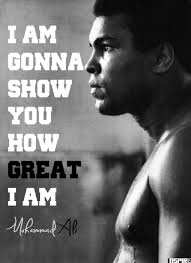 It was truly wonderful to see the well-deserved glowing and endearing remembrances of the Champ. It is very clear to me and most of the world that Ali is the “Greatest of All Times. This post is meant to remind you that at one point in Ali’s life, he was the most hated man in America for his resistance to the war. I say this to say, look what they did to Dr. King’s legacy and others; they made them tamed and in the case of Dr. King; they would have you think he only had a dream. History is full of such acts after the person is gone.
It was truly wonderful to see the well-deserved glowing and endearing remembrances of the Champ. It is very clear to me and most of the world that Ali is the “Greatest of All Times. This post is meant to remind you that at one point in Ali’s life, he was the most hated man in America for his resistance to the war. I say this to say, look what they did to Dr. King’s legacy and others; they made them tamed and in the case of Dr. King; they would have you think he only had a dream. History is full of such acts after the person is gone.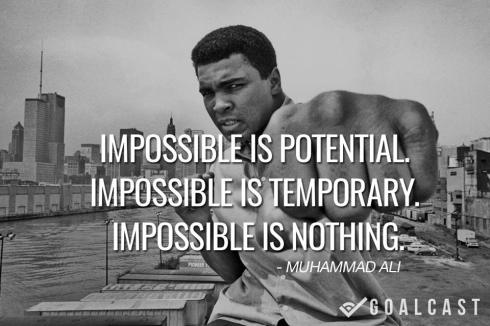
 We’ve all heard about the boxer called the “Greatest,” the baddest man on the planet, and the Brown Bomber but Sugar Ray Robinson (born Walker Smith Jr.) was the greatest boxer of all time! Robinson’s performances in the welterweight and middleweight divisions prompted sportswriters to create “Pound for Pound” rankings, where they compared fighters regardless of weight. He was inducted into the International Boxing Hall of Fame in 1990.
We’ve all heard about the boxer called the “Greatest,” the baddest man on the planet, and the Brown Bomber but Sugar Ray Robinson (born Walker Smith Jr.) was the greatest boxer of all time! Robinson’s performances in the welterweight and middleweight divisions prompted sportswriters to create “Pound for Pound” rankings, where they compared fighters regardless of weight. He was inducted into the International Boxing Hall of Fame in 1990.

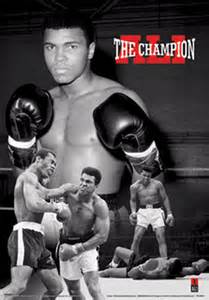
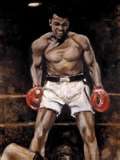






Still Looking For The Great White Hope
After all the hype, all the talk, and all the profanity, it simply was unrealistic to believe McGregor, the UFC champion, could beat Mayweather in their pay-per-view showdown last night at the T-Mobile Arena. So no one should have been surprised when Mayweather methodically broke down McGregor before scoring a 10th-round technical knockout. Honestly, I don’t think Mayweather broke a sweat the entire fight!
So what did we learn from this exercise? Well, it was entertaining! The best boxer on the planet and the UFC superstar brought a lot of attention to their respective sports, and those who spent $100 on pay-per-view and thousands to witness the bout in person must not have remembered that there is a sucker born every day. Surely this was not the best boxing has to offer. I guess McGregor was just happy he was still standing at the end.
Mayweather, who scored his first knockout since 2011, looked a bit rusty early on after having not fought in two years. His boxing inexperience showed, especially late in the fight when he tried to clinch. By the end, his face was a sitting target. As a boxing fan, this was a disgrace to me. However, I am glad the black guy got a 100 million dollar payday! And that’s my thought provoking perspective…
Share this:
Leave a comment | tags: Boxing, business, commentary, entertainment, Jack Johnson, Mayweather, McGregor, news, sports, Uncategorized | posted in African American, black issues, education, history, Politics